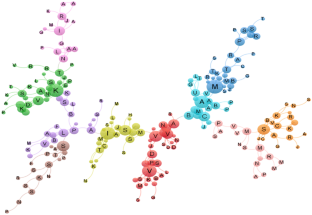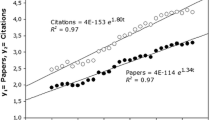Abstract
There is a great deal of disparity in the creation and dissemination of scholarly publications across disciplines. The main objective of the study in this article is three-fold: first, to find empirical evidence of publishing regularity in economics journals in India; second, to examine what accounts for author concentration in journals, with a special focus on economics; and third, to understand the nature of scholarly collaboration. For this, authorship data from eight Indian economics journals and the Economic and Political Weekly (EPW), a prestigious periodical encompassing a range of areas in social sciences, were manually obtained. This study contributes to existing literature by substantiating that author concentration is not merely an outcome of the degree of journal specialization. Interestingly, the study shows that a journal with generic readership is likely to form a power-law distribution. The computed measures of social network analysis indicate that collaboration in Indian economics, unlike in world economics, is in a nascent stage, consisting of a large number of isolated authors on the one hand, and some fragmented groups of varied sizes, on the other.

Source: data compiled by the author from EPW. Note: Fig. 1 is drawn using VOSviewer
Similar content being viewed by others
Notes
The government of India established the Indian Council of Social Science Research (ICSSR) in 1968 to support social science research in India.
All the authors were given equal weight in case of co-authorship.
This criterion applies to all journals except the Indian Journal of Economics. Authorship data compiled from the Indian Journal of Economics starts from 1962.
In this paper, the chi-square goodness of fit test is used to test the presence or absence of Lotka’s law. If the observed value is less than the critical value, the null hypothesis is accepted; otherwise, it is rejected. Acceptance of null hypothesis means the presence of Lotka’s law. Coile (1978) recommends application of the Kolmogorov–Smirnov (generally known as “K-S test”) statistic.
References
Aagaard, K., Kladakis, A., & Nielsen, M. W. (2020). Concentration or dispersal of research funding? Quantitative Science Studies, 1, 117–149.
Ahmi, A., Saidin, S. Z., Mohd Nasir, M. H., & Ismail, Z. (2020). Applicability of Lotka’s law in eXtensible business reporting language (XBRL) studies. International Journal of Advanced Science and Technology, 29, 282–289.
Bino Paul, G. D., & Krishna, M. (2011). Does network matter in knowledge activity. Science, Technology & Society: An International Journal, 16, 235–255.
Bino, P. G. D., Subash, S., & Ramanathan, A. (2005). Concentration in knowledge output: A case of economics journals. The European Journal of Comparative Economics, 2, 261–278.
Borgatti, S. P., Everett, M. G., & Freeman, L. C. (2002). Ucinet 6 for Windows: Software for social network analysis. Analytic Technologies.
Card, D., & DellaVigna, S. (2017). What do editors maximize? Evidence from four leading economics journals (No. w23282). National Bureau of Economic Research.
Chung, K. H., & Cox, R. A. K. (1990). Patterns of productivity in the finance literature: A study of the bibliometric distributions. The Journal of Finance, 45, 301–309.
Coile, R. C. (1978). Lotka’s frequency distribution of scientific productivity. Professional Paper No-216, Centre for Naval Analysis/University of Rochester, Virginia
Corbet, S., Dowling, M., Gao, X., Huang, S., Lucey, B., & Vigne, S. A. (2019). An analysis of the intellectual structure of research on the financial economics of precious metals. Resources Policy, 63, 101416.
Cowan, R., & Jonard, N. (2004). Network structure and the diffusion of knowledge. Journal of Economic Dynamics and Control, 28, 1557–1575.
Cowan, R. (2004). Network models of innovation and knowledge diffusion. MERIT Research Memoranda, 2004–01.
Cox, R. A. K., & Chung, K. H. (1991). Patterns of research output and author concentration in the economics literature. The Review of Economics and Statistics, 73, 740–747.
Da Silva, S., Perlin, M., Matsushita, R., Santos, A. A., Imasato, T., & Borenstein, D. (2019). Lotka’s law for the Brazilian scientific output published in journals. Journal of Information Science., 45, 705–709.
Dobusch, L., & Kapeller, J. (2013). Striking new paths: Theory and method in path dependence research. Schmalenbach Business Review, 65, 288–311.
Ellison, G. (2002). The slowdown of the economics publishing process. Journal of Political Economy, 110, 947–993.
Gans, J. S., & Shepherd, G. B. (1994). How are the mighty fallen: Rejected classic articles by leading economists. Journal of Economic Perspectives, 8, 165–179.
Goyal, S., Van Der Leij, M. J., & Moraga González, J. L. (2006). Economics: An emerging small world. Journal of political economy, 114, 403–412.
Granovetter, M. (1985). Economic action and social structure: The problem of embeddedness. The American Journal of Sociology, 91, 481–510.
Granovetter, M. (2005). The impact of social structure on economic outcomes. Journal of Economic Perspectives, 19, 33–50.
Guha, R. (2004). Passing EPW and the thinking Indian, accessed from www.himalmag.com/2004/february/passing.htm, February
Gupta, B. M., Dhawan, S. M., & Singh, U. (2009). Social science research in India. China and Brazil-A comparative study, DESIDOC Journal of Library and Information Technology, 29, 15–23.
Hamermesh, D. S. (1994). Facts and myths about refereeing. Journal of Economic Perspectives, 8, 153–163.
Hodgson, G. M., & Rothman, H. (1999). The editors and authors of economics journals: A case of institutional oligopoly. Economic Journal, 109, F165–F186.
Kawamura, M., C. D. L. Thomas, Y. Kawag. (2009). Lotka's law and the pattern of scientific productivity in the dental science literature. Medical Informatics and the Internet in Medicine, 24, 309-315
Klamer, A., & van Dalen, H. P. (2002). Attention and the art of scientific publishing. Journal of Economic Methodology, 9, 289–315.
Krishna, M., & Paul, G. B. (2017). The structure of collaboration networks: An illustration of Indian economics. Journal of Social Structure, 18, 0_1–18.
Lotka, A. J. (1926). The frequency distribution of scientific productivity. Journal of the Washington Academy of Sciences, 16, 317–323.
Lovell, M. C. (1973). The production of economic literature: An interpretation. Journal of Economic Literature, 11, 27–55.
Ministry of Human Resource Development (MHRD) (2016), data accessed from https://mhrd.gov.in/university-and-higher-education
Moody, J. (2004). The structure of a social science collaboration network: Disciplinary cohesion from 1963–1999. American Sociological Review, 69, 213–238.
Murphy, L. J. (1973). Lotka’s law in the humanities. Journal of the American Society for Information Sciences, 24, 461–462.
Newman, M. E. J. (2001). ‘The structure of scientific collaboration networks. Proceedings of the National Academy of Sciences, USA, 98, 404–409.
Potter, G. W. (1981). Lotka’s law revisited. Library Trends, 30, 21–39.
Schorr, A. E. (1975). Lotka’s law and map librarianship. Journal of the American Society for Information Sciences, 26, 189–190.
Scott, J. (2000). Social network analysis, a Handbook. (2nd ed.). Sage Publications.
Talukdar, D. (2011). Patterns of research productivity in the business ethics literature: Insights from analyses of bibliometric distributions. Journal of Business Ethics, 98, 137–151.
Trivedi, P. K. (1993). An analysis of publication lags in econometrics. Journal of Applied Econometrics, 8, 93–100.
Voos, H. (1974). Lotka and information science. Journal of the American Society for Information Science, 25, 270–272.
Wasserman, S., & Faust, K. (1994). Social network analysis: Methods and applications. Cambridge University Press.
Yalcintas, A. (2013). The problem of epistemic cost: why do economists not change their minds (About the “Coase Theorem”). American Journal of Economics and Sociology, 72, 1131–1157.
Author information
Authors and Affiliations
Corresponding author
Additional information
Publisher's Note
Springer Nature remains neutral with regard to jurisdictional claims in published maps and institutional affiliations.
Appendices
Appendix 1. Pattern of Scientific Productivity in Major Disciplines: an Overview
Study | Period | Subject field | No. of authors | Key findings |
|---|---|---|---|---|
Leavens (1953)* | 1933–1952 | Econometrics | 721 | Presence of Lotka’s lawa |
Murphy (1973) | 1959–1968 | Humanities | 170 | Presence of Lotka’s law |
Voos (1974) | 1966–1970 | Information Science | 11,005 | Absence of Lotka’s law |
Schorr (1975) | 1921–1973 | Map librarianship | 326 | Presence of Lotka’s law |
Radhakrishnan and Kernizan (1979)* | 1968–1972 | Computer Science | –– | Absence of Lotka’s law |
Chung & Cox (1990) | Inaugural to 1986 | Financial Economics | 6,270 | Presence of Lotka’s law |
Cox & Chung (1991) | 1963–1988 | Economics | 13,576 | Presence of Lotka’s law |
Kawamura et al. (2009) | 1971–1995 | Dental Science | 43,796 | Presence of Lotka’s law |
Talukdar (2011) | 1982–2009 | Business | 4030 | Absence of Lotka’s law |
Corbet et al. (2019) | 1990–2017 | Economics | 2521 | Presence of Lotka’s law |
Ahmi et al. (2020) | Until April 2020 | XBRL | 648 | Presence of Lotka’s law |
Appendix 2. Share of Top Three Institutional Contributors to Indian Economics Journals, 2005
Journals and period | Rank 1 | Rank 2 | Rank 3 | Total |
|---|---|---|---|---|
Institution (%) | Institution (%) | Institution (%) | (%) | |
IER (1966–2005) | Delhi School of Economics (12.1) | Indian Statistical Institute, Delhi (6.4) | Institute of Economic Growth (6.0) | 24.5 |
IEJ (1978–05) | University of Bombay (6.2) | University of Delhi (2.0) | Delhi School of Economics (1.7) | 9.8 |
JQE (1986–2005) | Indira Gandhi Institute of Development Research (5.5) | Reserve Bank of India (3.9) | Institute of Economic Growth (3.1) | 12.5 |
IJAE (1964–2005) | Punjab Agricultural University (7.7) | Indian Agricultural Research Institute (5.1) | IIM, Ahmadabad (3.3) | 16.1 |
IESHR (1985–2005) | University of Delhi (10.5) | Delhi School of Economics (6.1) | Jawaharlal Nehru University (3.2) | 19.7 |
Appendix 3. Some Papers Rejected by Leading Economics Journals and Journals that Published them
Author | Title of paper | Rejecting journal | Publishing journal |
|---|---|---|---|
Akerlof, George | The Market for “Lemons”: Quality, Uncertainty and the Market Mechanism | American Economic Review Journal of Political Economy Review of Economic Studies | Quarterly Journal of Economics (1970) |
Arthur, W. Brian | Competing Technologies, Increasing Returns, and Lock-In by Historical Events | American Economic Review Quarterly Journal of Economics American Economic Review Economic Journal | Economic Journal (1989) |
Becker, Gary S., | Competition and Democracy | Journal of Political Economy | Journal of Law and Economics (1958) |
Bhagwati, Jagadish | Immiserizing Growth: A Geometrical Note | Quarterly Journal of Economics | Review of Economic Studies (1958) |
Buchanan, James M | External and Internal Public Debt | Quarterly Journal of Economics | American Economic Review (1957) |
Friedman, Milton | Professor Pigou's Method for Measuring Elasticities of Demand from Budgetary Data | Economic Journal | Quarterly Journal of Economics (1935) |
Harrod, Roy | The Law of Decreasing Costs | Economic Journal | Economic Journal (1931) |
Krugman, Paul R., | Increasing Returns, Monopolistic Competition, and International Trade | Quarterly Journal of Economics | Journal of International Economics |
Modigliani, Franco | Fluctuations in the Savings-Income Ratio: A Problem in Economic Forecasting | Econometrica | Studies of Income and Wealth (1949) |
Stolper, Wolfgang, and Samuelson, Paul A | Protection and Real Wages | American Economic Review | Review of Economic Studies (1941) |
Appendix 4. Descriptive Statistics of Collaboration Networks: a Comparison
Network properties | EPW | Goyal et al. (2006) |
|---|---|---|
Authors in collaboration networks | 1840 | 56,639 |
Size of the giant component | 225 | 33,027 |
Average degree | 1.92 | 1.672 |
Average distance | 8.57 | 2.303 |
Clustering coefficient (overall) | 0.69 | 0.157 |
Rights and permissions
About this article
Cite this article
Muniyoor, K. The Structure of Scholarly Publishing: a Case of Economics Research in India. J Knowl Econ 13, 1801–1818 (2022). https://doi.org/10.1007/s13132-021-00797-8
Received:
Accepted:
Published:
Issue Date:
DOI: https://doi.org/10.1007/s13132-021-00797-8




